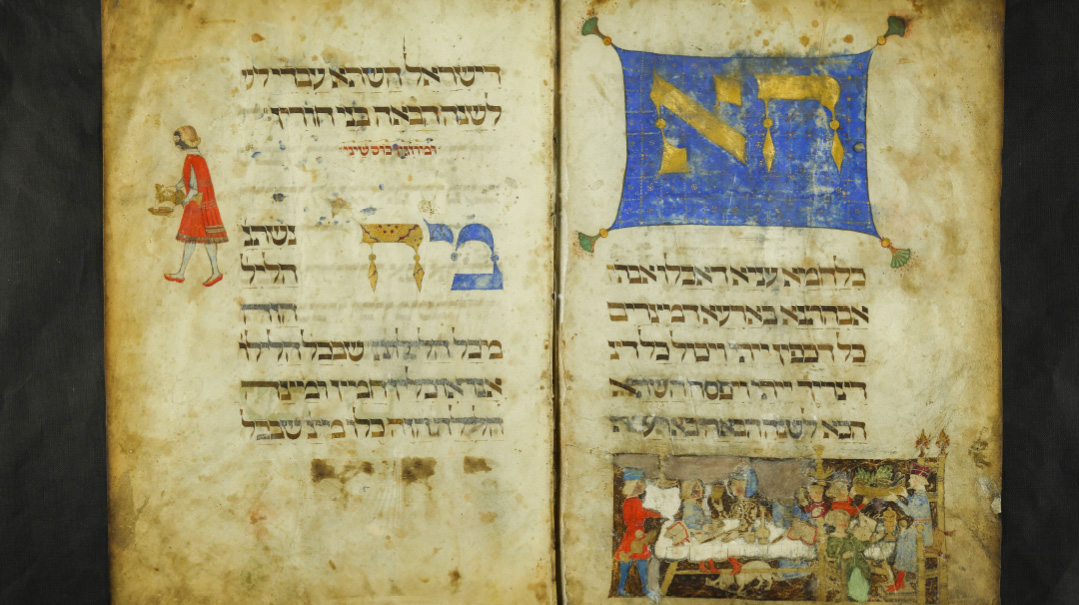Retell the Story
| April 9, 2024The world’s largest collection has 8,500 of them. Which Haggadah are you going to use this Pesach?

It’s a favorite collector’s item, and for good reason: In the two thousand years since the oral tradition of the Exodus was recorded in the form we’re all familiar with, the Haggadah has become the world’s most widely published Jewish text. The world’s largest collection has 8,500 of them. Which Haggadah are you going to use this Pesach?
W
hich Haggadah will you use this Pesach? Do you choose the same one year after year, every wine stain evoking a memory? Or do you enjoy a different Haggadah with a new peirush every year?
Whatever your preference, you have plenty to choose from. In the nearly two thousand years since the oral tale of our people’s salvation was recorded and took the form we’re so familiar with, the Haggadah has become the most widely published Jewish text. First handwritten and illustrated, then printed, the Haggadah has followed the Jewish People throughout the long journey of exile.
The National Library of Israel (NLI) houses the largest collection of Haggadahs in the world. Its 8,500 traditional Haggadahs — manuscripts, printed texts, scanned works — date from before the invention of modern printing up until today, and come from every part of the globe.
Let’s open some of these treasured Haggadahs of the National Library. We’ll move with them through the time and space that make up our people’s history since we were freed from slavery thousands of years ago to become Hashem’s nation.

Shadow of the Crusades
Rothschild Haggadah (Italy, 1450)
The National Library of Israel inaugurated a new building after Succos last year, but the scheduled gala opening was canceled due to the war. Without fanfare, the stunning new facility was opened to the public. But five items considered absolutely irreplaceable — including the Rothschild Haggadah — have been kept in safety storage, until the war’s end. If the Rothschild Haggadah could speak (pun intended), it might say that this wasn’t the first war it has faced.
Handwritten in Italy in 1450, the Haggadah became famous when it was bought late in the 19th century by Baron Edmond de Rothschild, known as “the Benefactor,” for his contributions to building up Eretz Yisrael. After his death, his son James in England inherited it. Unfortunately, before World War II, James sent the Haggadah to France. When the Nazis conquered France in 1940, they seized it, along with innumerable Jewish treasures, and took it to Germany, intending it to be part of their plan to build museums to retain the memory of the Jewish people they wanted to, chas v’shalom, wipe out.
Details of the Rothschild Haggadah’s postwar whereabouts are sketchy. In all likelihood, an American soldier rescued it. In any case, it ended up at Yale University, donated by an alumnus who bought it. In the 1980s, attempts to return looted artifacts bore fruit, and the Haggadah was returned to the Rothschild family, who donated it to the National Library of Israel.
The Rothschild Haggadah’s beautiful illustrations call to mind tribulations of earlier exiles. In the section of the Four Sons, there is a puzzling picture next to the Wicked Son, the rasha: A clean-shaven armored knight is clutching a small child in one hand, and in the other he is raising his sword. Though the chilling illustration has faded with time, at the feet of this clearly non-Jewish crusader, we see a Jewish man, kneeling. What is happening here? Is the Jew surrendering himself and his child to the crusader’s faith? We don’t know, but what is clear is that the 15th-century illustrator of the Rothschild Haggadah was working within living memory of the Crusades.
To recall Pharaoh’s command to throw Jewish male infants into the Nile, the Rothschild Haggadah illustrator created a terrifying picture of an Egyptian dressed in red drowning two babies. The red ink has spread “out of the lines” of the Egyptian’s clothing. This was probably a natural effect of the ink ageing on the parchment over centuries, but today it reminds us of the blood spilled in ancient Egypt, and of the plague of blood that spread to the Nile itself.
The words of Vehi She’amdah remind us that the war against our people has been fought in every generation: by Pharaoh, by Crusaders, by Nazis, and today, by Hamas, Hezbollah, and their supporters.
For now, the Rothschild Haggadah is sheltering in its miklat — like so many of our people who have found safety in their shelters during the present war. But every word of the Haggadah assures us that ultimately the enemies will fall and we will win. V’HaKadosh Baruch Hu matzileinu mi’yadam.
And when that happens, the Rothschild Haggadah will be taken out of storage to be proudly displayed in its true home, in Yerushalayim.
Oops! We could not locate your form.







